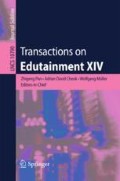Abstract
China is an earthquake-prone countries, so it’s important to carry out earthquake escape education which has practical significance. The traditional way of earthquake escaping education is not vivid enough, also lacking the sense of reality or interactivity, so to arouse the learner’s interest proved to be very difficult. Based on the constructivism learning concept, a new educational method for assisting earthquake escaping was proposed based on animation simulation technology. Using virtual reality engine an animation game was developed, in which virtual scenes were created, animation character was modeled, the motion controlling method for virtual characters was constructed, and particle animation was used so as to achieve earthquake effects. The prototype of this demonstration system can run in a browser, which makes it easy to promote. Preliminary tests show that users prefer this new educational method for earthquake escaping to the old ones. Electronic document is a “live” template. The various components of your paper [title, text, heads, etc.] are already defined on the style sheet, as illustrated by the portions given in this document.
Access this chapter
Tax calculation will be finalised at checkout
Purchases are for personal use only
References
Zhang, M., Bao, W., Xiong, Z., Xu, W.: ERT-VR: virtual simulation system for training earthquake rescuers. J. Syst. Simul. 16, 3693–3696 (2007)
Jia, Q., Zhou, B.: Earthquake disaster scenario simulation technology. J. Comput. Res. Dev. 16, 177–202 (2008)
Roussou, M., Oliver, M., Slater, M.: The virtual playground: an educational virtual reality environment for evaluating interactivity and conceptual learning. Virtual Real. 10(3–4), 227–240 (2006). (S1359-4338)
Xuan, Y.: Unity 3d Game Development. People Posts and Telecom Press, Beijing (2012)
Sun, B.: The implementation of three-dimensional seismic damage simulation system. Earthq. Eng. Eng. Vibr. 5, 1–8 (2010)
Liu, B., Wang, Z., Wang, L., Hua, W., Peng, Q.: Efficient modeling and real-time rendering of large-scale urban scenes. J. Comput. Aided Des. Comput. Graph. 9, 1153–1162 (2008)
Author information
Authors and Affiliations
Corresponding author
Editor information
Editors and Affiliations
Rights and permissions
Copyright information
© 2018 Springer-Verlag GmbH Germany
About this chapter
Cite this chapter
Hu, W., Zheng, Y. (2018). Study of Animation Simulation Technology for Earthquake Escape Education. In: Pan, Z., Cheok, A., Müller, W. (eds) Transactions on Edutainment XIV. Lecture Notes in Computer Science(), vol 10790. Springer, Berlin, Heidelberg. https://doi.org/10.1007/978-3-662-56689-3_12
Download citation
DOI: https://doi.org/10.1007/978-3-662-56689-3_12
Published:
Publisher Name: Springer, Berlin, Heidelberg
Print ISBN: 978-3-662-56688-6
Online ISBN: 978-3-662-56689-3
eBook Packages: Computer ScienceComputer Science (R0)

